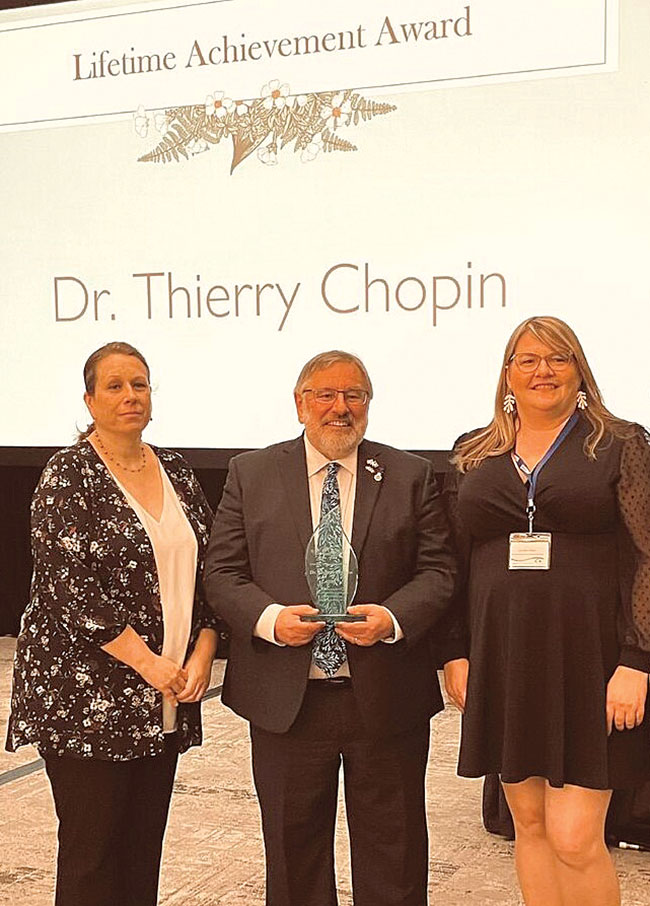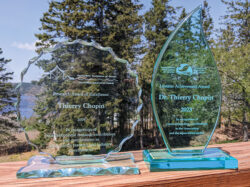
A lifetime harnessing the power of seaweed and IMTA
August 8, 2023
By Dr. Thierry Chopin, University of New Brunswick, Turquoise Revolution Inc.
 Thierry Chopin with Joanne Burry (left), conference manager, and Jennifer Wiper, president of the Aquaculture Association of Canada. Photo: Kathy Chopin
Thierry Chopin with Joanne Burry (left), conference manager, and Jennifer Wiper, president of the Aquaculture Association of Canada. Photo: Kathy Chopin On May 9, I was very honoured and pleased to receive the 2023 Lifetime Achievement Award of the Aquaculture Association of Canada (AAC) at the Aquaculture Canada 2023 annual conference in Victoria, B.C.
I am now in excellent company as one of 18 recipients of the AAC Research Award of Excellence and 16 recipients of the AAC Lifetime Achievement Award.
The title of my acceptance speech was, “Forty-three years with seaweeds, 34 years at the University of New Brunswick, 27 years with the Aquaculture Association of Canada, 20 years of Integrated Multi-Trophic Aquaculture (IMTA)… Let’s celebrate!”
Receiving this award at the very same place where, 20 years ago, during Aquaculture Canada 2003, I mentioned the expression “Integrated Multi-Trophic Aquaculture” and the acronym “IMTA” for the first time, had a very special meaning for me. Since then, more than 1,500 publications have been published about IMTA, attesting to the topicality of this sustainable aquaculture practice.
One of my proudest accomplishments during the nine years (2009-2017) of the existence of the Canadian IMTA Network (CIMTAN) is to have participated in the training of 143 highly qualified personnels, who are now the next generation of IMTA ambassadors.
I learned three important things during these pioneering years. First, the old adage “the second mouse gets the cheese” is so very true. Second, like in any organization, five percent of the people give you 95 percent of the headaches. Third, you will be able to count who your real friends are when you stop distributing the money.
I took the opportunity to mention a number of other things we learned as IMTA evolved. For example, IMTA does not mean that fish have to be part of the system. We started with salmon, kelps and mussels because that was the combination we could have in the Bay of Fundy at that time. However, because the IMTA concept is extremely flexible and can be applied worldwide to open-water and land-based systems, marine and freshwater environments, and temperate and tropical climates, and because there are many combinations of different marine resources possible by taking advantage of the local biodiversity to select appropriate species based on their complementary functions in the ecosystem, economic values and societal acceptability, there is no ultimate IMTA system to feed the world. It should be abundantly clear that IMTA is a concept, not a formula.
The different components of an IMTA system do not have to be constrained to the limits of existing finfish sites. That is how we started with the regulations in place in the Bay of Fundy at that time, but it does not reflect the ecosystem scales at which aquaculture farms really function. We need to move to an Integrated Coastal Area Management (ICAM) strategy, in which several horizontally integrated companies coordinate their activities within the ICA, instead of having one vertically integrated company trying to do everything.
Until now, seaweed (and the other extractive species) have been valued only for their biomass and food trading values. However, to calculate IMTA’s full value, they also need to be valued for the ecosystem services they provide, along with the increase in consumer trust and the societal/political license to operate that they give to the aquaculture industry within a circular economy approach. In a recently published book chapter, I identified 27 ecosystem services provided by seaweeds. Among them, I will cite the following:
- Seaweed are excellent nutrient scrubbers (especially dissolved nitrogen, phosphorus and carbon);
- Seaweed do not need to be irrigated with freshwater, but they need seawater, of good quality;
- Seaweed can be cultivated without fertilizers and agrochemicals, but they need nutrients in the water;
- Seaweed cultivation does not need more arable soil and land transformation (deforestation);
- Seaweed can be used for habitat protection, restoration and for increasing biodiversity. This is a rare situation where you can have more habitat and eat it too!
- Seaweed is the aquaculture component providing oxygen, while the other animal and microbial components consume oxygen;
- Seaweed store, or transiently “sequester” carbon while they grow and can contribute to the slowing down of global warming. However, when they are harvested and processed, carbon is also transformed and enters the fast carbon cycle, i.e. it is not permanently sequestered. No double dipping/accounting, please!
- By transiently “sequestering” carbon, seaweeds could also reduce coastal acidification.
- Seaweed (and other seafood) can participate in the decarbonization of this world by being part of the dietary shift towards food production systems with a lower carbon footprint than terrestrial ones, and the mitigation of nutritious food insecurity.
There are presently no logical economic incentives to grow seaweed for sinking them to the deep-sea ecosystems for carbon sequestration. Canada is one of few countries to have a carbon tax scheme in place. On April 1 , the tax increased to CA$65 (US$48.40) per ton of carbon. Using an average carbon composition in seaweeds of three percent fresh weight (FW), this can be converted to a carbon tax (or carbon credit) of US$0.0145 per kilogram dry weight (DW) of seaweed. This price for carbon sequestration is unattractive compared to the price of seaweed in other markets, which can vary from a few U.S. dollars to more than US$1,000/kg DW, depending on the applications.
The value of the ecosystem services provided by seaweed, and other extractive components of IMTA systems, will have to be recognized, then monetized, then, used as financial and regulatory incentive tools. A key ecosystem service provided by seaweeds is nutrient biomitigation and a monetary value can be calculated for this service by the worldwide seaweed aquaculture (35.1 million tons FW in 2020): between US$2.6 billion and US$5.1 billion, i.e. as much as 30.9 percent of its present commercial value (US$16.5 billion).
Over the last decade, much emphasis has been placed on carbon. In coastal environments, issues associated with other nutrients, such as nitrogen and phosphorus, are significant and should be addressed. Interestingly, there is more money to be made with NTCs than with carbon trading credits (CTCs): between US$2.5 and $4.9 billion for nitrogen and US$140.4 million for phosphorus, compared to only US$51.0 million for carbon. It is, therefore, important that we go beyond this quasi-obsession with carbon and look at the impacts of nutrients, like nitrogen and phosphorus, which are also playing key roles in climate change, ocean acidification and biodiversity.
We also need to integrate the economic, societal and regulatory aspects of IMTA. The aquaculture industry always says “Show us that IMTA makes sense economically.” Well, I would like to remind you that between 2007 and 2019, we produced 11 publications on the economic value and benefits of IMTA. All 11 publications are based on numbers provided by the industry, for which we are grateful, and representatives of the industry are co-authors on these papers. In all scenarios, IMTA is more profitable than salmon monoculture. So, why do we still hear this line of questioning? Be pro-active, accept that the economic demonstration has been done with your data, and, consequently, adopt IMTA more rapidly.

Thierry Chopin received the Aquaculture Association of Canada Research Award of Excellence in 2009, and the Lifetime Achievement Award in 2023.
Photo: Thierry Chopin
We have to take into consideration the intangible societal benefits of IMTA. For example, what is the value of David and Sarika Suzuki visiting an IMTA site and shooting a CBC television episode, which is regularly heard on CBC? Is that not part of increasing consumer trust and societal/political license to operate for the aquaculture industry as a whole?
We got our seaweeds organically certified, and the salmon grown at IMTA sites got differentiated as “WiseSource Salmon” by the largest food distributor in Canada, Loblaw/Superstore. We worked on developing a premium market price. People smiled at us, indicating that if we got five percent we would be extremely lucky. We got 11 percent during two years, until CIMTAN ceased operating.
We need timely and enabling regulatory changes, instead of the current hampering regulatory hurdles. In Canada, and several other countries, aquaculture legislation was written for salmon farms in the 1980s, particularly to combat diseases in intensive monocultures. It is now clear that these regulations may inadvertently prevent innovation in aquaculture practices. We need to evolve towards a more holistic approach, considering species interactions, ecosystem-base management and an ICAM strategy.
Six years ago, when CIMTAN was fully active, Canada was ahead along the IMTA research, development and commercialization continuum. Since we are, unfortunately, no longer ahead, I remain involved with the progression of the concept and the training of bright minds, notably with the ASTRAL consortium in Europe, Africa and South America. I advise other projects in other parts of the world. Sadly, I cannot restrain myself from shouting very loudly, “Where are you Canada? Wake up Canada!”. We are back to “the second mouse gets the cheese” and it is very frustrating.
In recent years, we have heard a lot about blue growth/blue economy/blue revolution. However, we should recognize that it needs to become greener. It is more than time that we combine “green thumbs” and “blue thumbs”, to talk about turquoise growth, economy, and revolution. IMTA already contributes to the United Nations Sustainable Development Goal (SDG) 14 (“Life below water”), but also to 10 other SDGs. This is one of the solutions for designing the sustainable food production systems of the future and the production of numerous non-food applications.
At the end of my presentation, I could not resist leading the audience to join me in my well-known IMTA dance to the tune of YMCA by Village People, and I received many kind words for my interesting mix of messages and fun in my acceptance speech.





